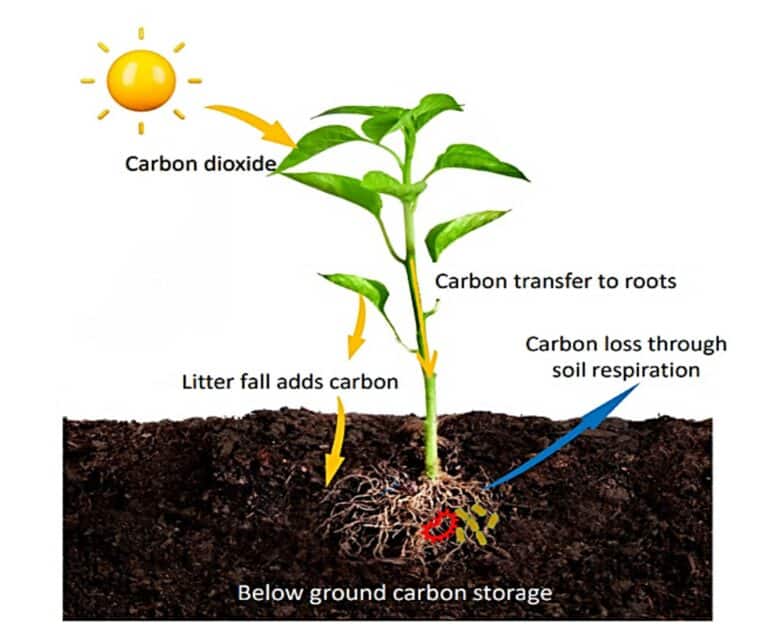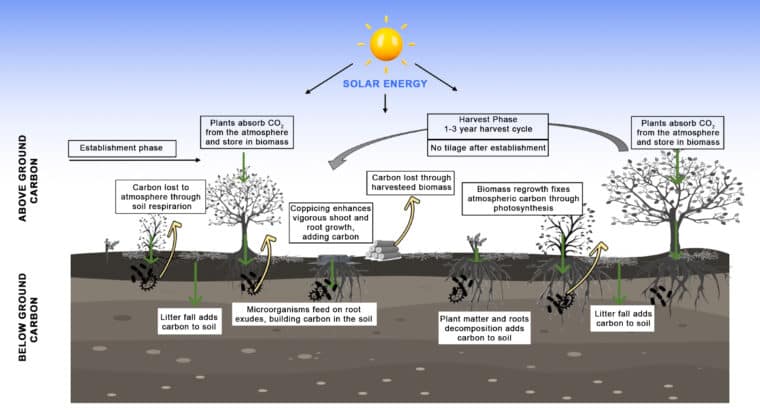What effect does planting biomass crops have on soil carbon?
Take home messages:
- Biomass crops accumulate relatively large quantities of below and above ground biomass which is made of carbon sequestered from the atmosphere.
- The frequent harvest of above ground biomass enhances vigorous shoot regeneration and root turnover, which enhances soil carbon stock.
- Biomass crops after establishment, requires no tillage during the lifetime of the plant, which enhances soil carbon stock when compared with annual crop soils which are regularly ploughed.
Introduction
Biomass crops play a key role in the UKs Net Zero Strategy which sets out how the UK will deliver on its commitment to reach net zero emissions by 2050. Biomass crops have the potential to contribute to this target by producing renewable energy, reducing greenhouse gas emissions, and supporting soil carbon (SOC) sequestration; the long-term storage of carbon (C) in soil. SOC provides the benefit of enhancing soil quality, increase supply and quality of water, improve biodiversity, and reduce atmospheric CO2. Unfortunately, our soils are depleted of SOC and degraded, largely affected by land use, soil management and farming systems. Intensive agriculture has caused UK’s arable soils to lose about 40 to 60% of organic carbon. There is the need to restore soil carbon and increase SOC stock in the soil by adopting management practices that enhances soil carbon concentration in the soil. Planting biomass crops provide a mechanism to enhance soil carbon. In this article we focus on the effect of planting biomass crops on soil carbon.
Fundamentals of soil carbon
Soils contain two to three times more carbon than the atmosphere, and a relatively small increase in the stocks could exert a significant role in mitigating green-house gas emissions. The challenge in the management of soil carbon is to conserve existing soil carbon stocks and to remove carbon from the atmosphere by adding to stocks retained in the soil. Soil carbon sequestration is one way to reduce CO2 loss into the atmosphere and increase the pool of carbon stored in the soil. Soil carbon sequestration is the transfer of atmospheric CO2 into soil via plants. Soil carbon sequestration is considered a key measure to mitigate climate change and improve soil health.
Soil carbon is the solid carbon stored in soils. There are inorganic and organic soil carbon forms. Inorganic soil carbon is predominantly found in carbonate minerals derived from weathering of rocks and minerals, whereas soil organic carbon (SOC) is the carbon found in soil organic matter (SOM). SOM is organic material (e.g., plant tissues, microorganisms, animals) in various stages of decomposition in the soil. SOC is an important component of the functioning of the ecosystem. It helps to improve soil structure and provides resilience to physical degradation. This reduces risks of soil erosion and nutrient leaching from the soil. Keeping SOC in the soil helps to reduce emissions of atmospheric CO2, increases microbial activity, improves soil aeration and increases water storage and availability to plants.
Figure 1. shows a simplified diagram on how carbon is transferred between the atmosphere, plants and soil of our ecosystem. SOC is formed from the interaction of ecosystem processes such as photosynthesis, respiration and decomposition of SOM.
- During photosynthesis, light energy is captured by plants and used to convert CO2 absorbed by the plants from the air, and water from the soil, to build carbohydrates which acts as a source of food for plant growth.
- Atmospheric carbon fixed in the plant leaves and branches are transferred down through the roots to the soil.
- Plants exude carbon through their roots to feed soil microorganisms.
- The microorganism in the soil decomposes organic residue such as fallen leaves, branches and roots in the soil releasing carbon deep into the soil. During this process, the soil microorganisms release CO2 into the atmosphere through respiration.
Thus, there is an inflow of CO2 into the soil (carbon inflow) and CO2 moving out of the soil (carbon outflow). Soil therefore acts as a source or as a sink for atmospheric CO2. The amount of carbon present in soil depends largely on the rate of decomposition of soil organic carbon to CO2 by microorganisms and the rate of SOM input into the soil. The more SOM input, the greater the residence time, and the more carbon that is locked out of the atmosphere.
Current state of soil carbon in UK soils
A study reports average densities of soil organic carbon of 133 t C ha−1 and 164 t C ha−1 in England and Wales. The study further reports that to increase these stocks by 0.4% to this depth each year would require annual sequestration of 0.534 t C ha−1 in England and 0.656 t C ha−1 in Wales. A report on the state of soils in UK, indicated that, UK soils currently store about 10 billion tonnes of carbon which is roughly equal to 80 years of annual UK greenhouse gas emissions. Soil degradation leads to increased carbon emissions and could speed up climate change. Land use, soil management and farming systems, influences the SOM causing a net addition or depletion of soil carbon stocks. Intensive agriculture has caused UK’s arable soils to lose about 40 to 60% of organic carbon.
Restoring soil carbon is essential to enhance soil quality necessary to sustain and improve food production, increase supply and quality of water, enhance biodiversity, reduce atmospheric CO2 among other benefits. Restoring soil carbon in degraded lands requires increasing SOC concentration in the soil by adopting best management practices. One option could be to plant perennial biomass crops that live for 10-20 years and accumulate biomass which is made of carbon. Several UK government policies have called for actions to sustainably manage UK soils to prevent degradation, advocating for measures to protect and enhance soil carbon stocks. In managing UK soils, biomass has a key role to play in improving soil carbon and resilience to climate change.
Biomass crops and Soil Carbon
Biomass crops are non-food crops grown for energy production. They are usually perennial woody or herbaceous plants. Some commonly grown woody biomass crops are short rotation crop willow (salix spp), poplar (populus spp) and short rotation forestry. Examples of herbaceous biomass crops are Miscanthus (Miscanthus giganteus) and switch grass (Panicum spp). The advantages of using these crops for biomass production include rapid growth rate and high biomass production, low nutrient requirement, and ability to re-sprout after multiple harvests. They are considered to have the potential to sequester large volumes of CO2 captured from the atmosphere during plant growth through photosynthesis and store carbon in the soil. The benefit of biomass crops sequestering carbon makes it an important crop in contributing to reducing greenhouse gas (GHG) emissions.
Biomass crops accumulate relatively large quantities of below and above ground biomass which is made of carbon sequestered from the atmosphere. Biomass crops produce high amounts of biomass above and below ground. The fallen leaves and branches also add organic matter to the soil. Studies have shown that leaving Miscanthus crop standing over winter increases litter fall at around 30-45% leading to the accumulation of biomass on the soil surface. Miscanthus organic material is shown to have a slow decomposition rate and is predicted to have the potential to store between 2-3 metric tonnes depending on the crop yield and the initial organic carbon level.
Biomass crops are harvested every 1-3 years during the lifetime of the crop. A process termed coppicing. Coppicing involves cutting down the tree or above ground biomass to its base and allowing it to reshoot multiple stems. After a few years, the stem or above ground biomass can be harvested, and the cycle begins again. The frequent harvest of above ground biomass enhances vigorous shoot regeneration and root turnover, which enhances soil carbon stock.
The root structure of biomass crop after establishment continuously grows throughout the life cycle of the plant, storing and transferring carbon to the soil. After coppicing the above ground biomass, the roots are left in the soil and continue growing. Perennial rhizomatous grasses such as Miscanthus allocates a large proportion of the aboveground carbon to the roots and rhizomes, further increasing soil organic carbon stocks. Miscanthus contributes 0.98 ± 0.14 Mg C4-C ha−1 yr−1 through litter drop and root turnover.
Biomass crops after establishment, require no tillage during the lifetime of the plant, which enhances soil carbon stock by minimising disturbance to the soil. Tilling (ploughing) soils reduces SOC stocks in the soil through enhancing soil aeration and reducing the physical protection of SOM, leading to increased decomposition rates and release of CO2 into the atmosphere. After establishment of biomass crops on the soil, the soil is not tilled, thus, there is less disruption of soil aggregates and exposure of SOM to microbial activities. For example, a study found that, SRC willow planted in South England had lower soil respiration (912 ± 42 g C m-2 yr-1 ) and a net sink for carbon (221 ± 66 g C m2 yr1). Substantial amount of carbon can be stored in the soil when the land is less ploughed.
The amount of carbon stored in the soil largely depends on the initial soil carbon content and prior land use. Planting biomass crops on lower carbon soils, such as arable lands, minimizes soil carbon losses and promote soil carbon sequestration in the long term. Studies have shown, that soils with high carbon stock such as grasslands, forest and peatlands have high carbon stock and conversion to planting of biomass crops is likely to result in soil carbon loss. It is recommended that Landowners and managers should measure the carbon stock prior to planting biomass crops to better predict soil carbon stock change after planting biomass crops.
Conclusion
Soil Organic Carbon (SOC) is formed from the interaction of ecosystem processes such as photosynthesis, respiration and decomposition of SOM. Soil carbon provides the benefit of enhancing soil quality which is essential to sustain and improve food production, increase supply and quality of water, enhance biodiversity, and reduce atmospheric CO2. Planting biomass crops could provide a mechanism to enhance soil carbon. Biomass crops have high above ground and below ground biomass which stores a significant amount of carbon in the plant. Coppicing above ground biomass enhances vigorous shoot regeneration and root turnover which enhances soil carbon stocks. Furthermore, biomass crops after establishment, requires no tillage during the lifetime of the plant, which facilitates better accumulation of soil carbon. For these reasons, planting biomass crops help to improve soil quality, provide resilience to physical soil degradation and help mitigate climate change.
Article Audio
Listen to an audio version of this article.





